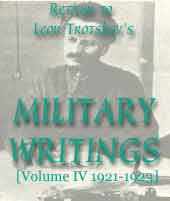
The 2nd Infantry Division has now received the title of ‘Tula Division’. It has been adopted by the Tula Soviet of workers’, peasants’ and Red Army men’s deputies. Thereby a close, intimate, unbreakable bond has been established between the 2nd Infantry Division and the working people of Tula Province.
In the Tsarist army military units had their patrons, that is, their ‘honorary’ commanders and protectors. These patrons were members of the Romanov family, Grand Dukes and Duchesses, and their foreign ‘kinsfolk’ – Kings, Emperors, Queens. Between the Imperial patrons and the mass of the soldiers in their units there was the same bonds as between slave-holders and their slaves.
The workers’ and peasants’ army now also has it ‘patrons’. [1] These are not individuals, however, but local organs of the workers’ and peasants’ power. Particular divisions, brigades and regiments are placed under the special care of particular local soviets. This measure has now become possible thanks to the fact that our army has – temporarily, until there is a new attack on us, that is, until another war begins – become more settled. Divisions occupy certain areas for a longer period than before. In this way a closer, more real, and not merely formal bond is acually being established between military units and the local organs of the workers’ and peasants’ power.
What does the attachment of divisions and regiments to soviets mean? It does not, of course, mean the dismemberment of the united Red Army into a series of local armies, such as we had in the very first period of Soviet power, in the period when the army was formed on guerrilla lines. No, the army is still a united, state-wide, strictly centralised whole. In that lies its strength, that is the guarantee of its further successes. By taking a certain unit of the army under their special care, the local soviets in no way sever the bond between this unit and the whole, that is, the bond with the army as a whole, but, on the contrary, they help to foster in every Red Army man the lofty consciousness that he is a citizen-soldier, a defender of the first republic of labour in the world, and thereby they strengthen the inner solidarity of all the units of the army and the solidarity of the army as a whole with all the working people. The bond between the local soviets and the divisions they adopt will, of course, be not formal but serious and practical in character. It is already like that, in fact. Even before the order was issued attaching the 2nd Infantry Division to the Tula Soviet, the latter had succeeded in giving serious, practical attention to it. The Soviet had already made available for the division’s needs, out of its own meagre resources, a considerable number of articles of equipment. The care shown by the Tula Soviet for its division in respect of accommodation, clothing and food will certainly not decline in the future. It is not possible, of course, to look for any miracles in this regard, for the economic position of the whole country, including Tula Province, is still extremely grave. But, to the extent that local forces and resources permit, the Tula Soviet will do all that it can to help the central government, so as to create for the Tula division more favourable conditions of existence both spiritual and material.
The division must, in its turn, show the greatest care for the local Soviet organs and for the conditions of living and the needs of Tula Province. In many cases the division can render very substantial aid to the local soviet organs, without encroaching upon its own current work in maintaining, training and educating the constituent units of the divisions.
The coming winter will be a time of intense, tireless work at the training and education of the division’s units, at strengthening the apparatus, and at bringing order into the sphere of its material equipment. The commanders and commissars face the task of raising their own level, so as then, in their wake, to raise the level of the entire mass of Red Army men. The Tula Soviet will help the division in the performance of this intense work, pporting it and strengthening its spirit. Let us get down to work together!
1. With the end of the civil war and the settlement of the peacetime locations of the troops, the question arose of bringing about closer links between Red Army units and local soviet, Party and trade-union organisations. A number of towns and districts expressed at the end of 1920 their desire to assume direct care for divisions which were stationed in their respective areas, or which they specially singled out.
In this way the idea of ‘patronage’ arose. The Revolutionary War Council of the Republic, taking steps to meet this desire, ordered (Order No.2797559) that a number of divisions be attached to various towns and districts, being given the names of these places. The first such attachments were: the 7th Infantry Division to the town of Vladimir, the 46th Infantry Division to the town of Yekaterinoslav, the 52nd Infantry Division to the town of Yekaterinburg, the 26th Infantry Division to the town of Zlatoust, the 51st and 56th Infantry Divisions to Moscow, the 11th and 12th Infantry Divisions to Petrograd, etc. Confirmation of these attachments and formal establishment of the practice of ‘patronage’ was also given in the decree of the All-Russia Central Executive Committee on November 17, 1921. In a period when material conditions were particularly hard for the Red Army units, the ‘patrons’ did a great deal of valuable work for the army by repairing barracks and providing a certain minimum comfort for those living in them.

Last updated on: 28.12.2006